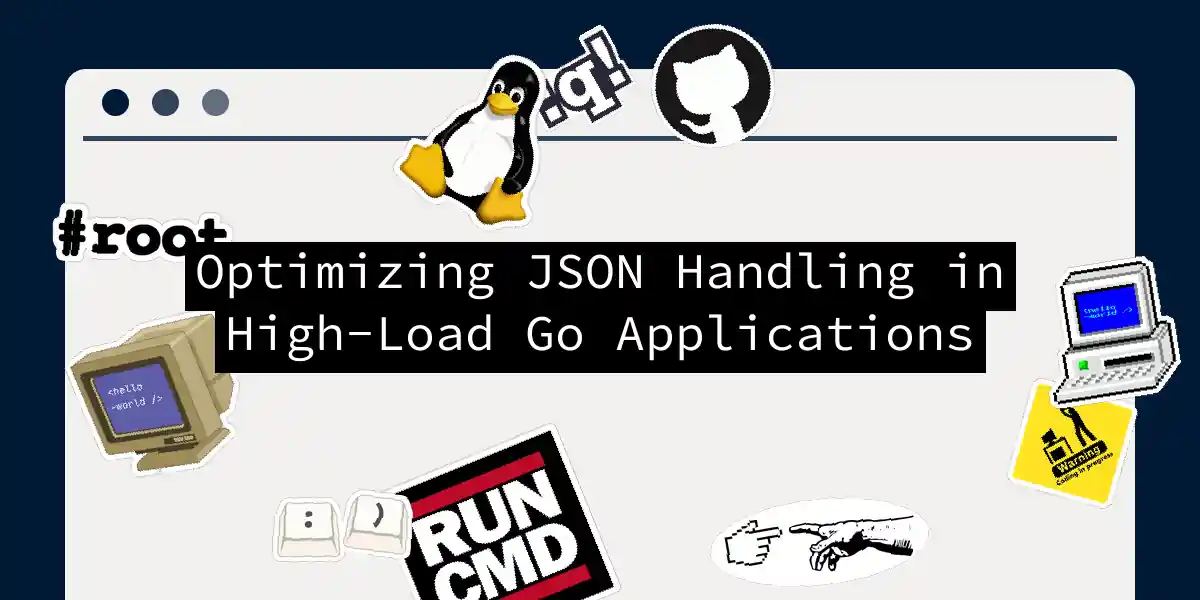The JSON Conundrum: Why Optimization Matters
JSON, or JavaScript Object Notation, is a ubiquitous data interchange format that has become the backbone of modern web development. However, its versatility and widespread adoption come with a cost: performance. In high-load Go applications, efficient JSON handling is crucial to maintain responsiveness and scalability. In this article, we’ll delve into the world of JSON optimization, exploring practical strategies, code examples, and best practices to make your Go applications faster and more efficient.
Understanding the Problem
JSON parsing and marshaling can be expensive operations, especially when dealing with large datasets. The standard encoding/json package in Go, while reliable, has its limitations. Here are some key issues:
- Allocation Overhead: The standard library allocates a significant amount of memory during JSON parsing, which can lead to increased garbage collection overhead and slower performance[2][3].
- Time Complexity: JSON parsing involves reading the input and following a state machine to identify tokens, which can be time-consuming, especially for large inputs[3].
Minimizing Data Size
Before diving into the intricacies of JSON parsing libraries, let’s start with the basics: reducing the size of your JSON data.
Use Short, Descriptive Keys
Concise key names can significantly reduce the size of your JSON objects.
// Inefficient
{
"customer_name_with_spaces": "John Doe"
}
// Efficient
{
"customerName": "John Doe"
}
Abbreviate When Possible
Using abbreviations for keys or values can further shrink your JSON payload.
// Inefficient
{
"transaction_type": "purchase"
}
// Efficient
{
"txnType": "purchase"
}
Minimize Nesting
Deeply nested arrays and objects can complicate parsing and increase processing time.
// Inefficient
{
"order": {
"items": {
"item1": "Product A",
"item2": "Product B"
}
}
}
// Efficient
{
"orderItems": ["Product A", "Product B"]
}
Optimizing Number Representations
Using integers instead of floating-point numbers where possible can also help.
// Inefficient
{
"quantity": 1.0
}
// Efficient
{
"quantity": 1
}
Using Efficient JSON Parsing Libraries
While the standard encoding/json package is reliable, there are more efficient alternatives available.
jsoniter
The jsoniter library is a popular choice for high-performance JSON parsing. It offers better throughput and reduced allocations compared to the standard library.
import (
"github.com/json-iterator/go"
)
func main() {
json := jsoniter.ConfigCompatibleWithStandardLibrary
var data map[string]interface{}
err := json.Unmarshal([]byte(jsonData), &data)
if err != nil {
// Handle error
}
}
jsoniter supports streaming operations and exposes an Iterator API, allowing you to build the final JSON object on the fly as you parse tokens from the input stream. This approach significantly improves allocation efficiency and overall system performance[2].
pkg/json
For even more aggressive optimization, the pkg/json package offers a high-performance JSON parser designed to eliminate allocations through API design. This package is particularly effective for large inputs and can deliver over 1 GB/s parsing throughput.
import (
"github.com/cespare/pkg/json"
)
func main() {
var data map[string]interface{}
err := json.Unmarshal([]byte(jsonData), &data)
if err != nil {
// Handle error
}
}
Here’s a comparison of the performance characteristics of these libraries:
Using Compression
Compression can significantly reduce the size of JSON payloads during transmission, which in turn reduces the time spent on parsing.
Gzip Compression Example
Here’s an example using Node.js and the zlib library, but the concept applies to any language:
const zlib = require('zlib');
const jsonData = {
// Your JSON data here
};
zlib.gzip(JSON.stringify(jsonData), (err, compressedData) => {
if (!err) {
// Send compressedData over the network
}
});
In Go, you can use the compress/gzip package:
import (
"bytes"
"compress/gzip"
"encoding/json"
"io"
)
func main() {
var data map[string]interface{}
// Populate data
var buf bytes.Buffer
gw := gzip.NewWriter(&buf)
err := json.NewEncoder(gw).Encode(data)
if err != nil {
// Handle error
}
gw.Close()
// Send buf.Bytes() over the network
}
Server-Side Caching
Implementing server-side caching can reduce the need for repeated JSON processing.
import (
"encoding/json"
"net/http"
)
var cache = make(map[string][]byte)
func jsonHandler(w http.ResponseWriter, r *http.Request) {
if cached, ok := cache[r.URL.Path]; ok {
w.Write(cached)
return
}
var data map[string]interface{}
// Populate data
jsonBytes, err := json.Marshal(data)
if err != nil {
// Handle error
}
cache[r.URL.Path] = jsonBytes
w.Write(jsonBytes)
}
Profiling and Optimizing
Use profiling tools to identify bottlenecks in your JSON processing code and optimize those sections.
import (
"net/http"
"net/http/pprof"
)
func main() {
http.HandleFunc("/debug/pprof/", pprof.Index)
http.ListenAndServe("localhost:6060", nil)
}
You can then use tools like go tool pprof to analyze the performance profile.
Conclusion
Optimizing JSON handling in high-load Go applications is a multifaceted task that involves reducing data size, using efficient parsing libraries, applying compression, implementing server-side caching, and profiling for performance bottlenecks. By following these strategies, you can significantly improve the performance and efficiency of your applications.
Remember, every byte counts, and every optimization can make a difference in the performance of your high-load Go applications. So, the next time you’re dealing with JSON, don’t just parse it—optimize it
